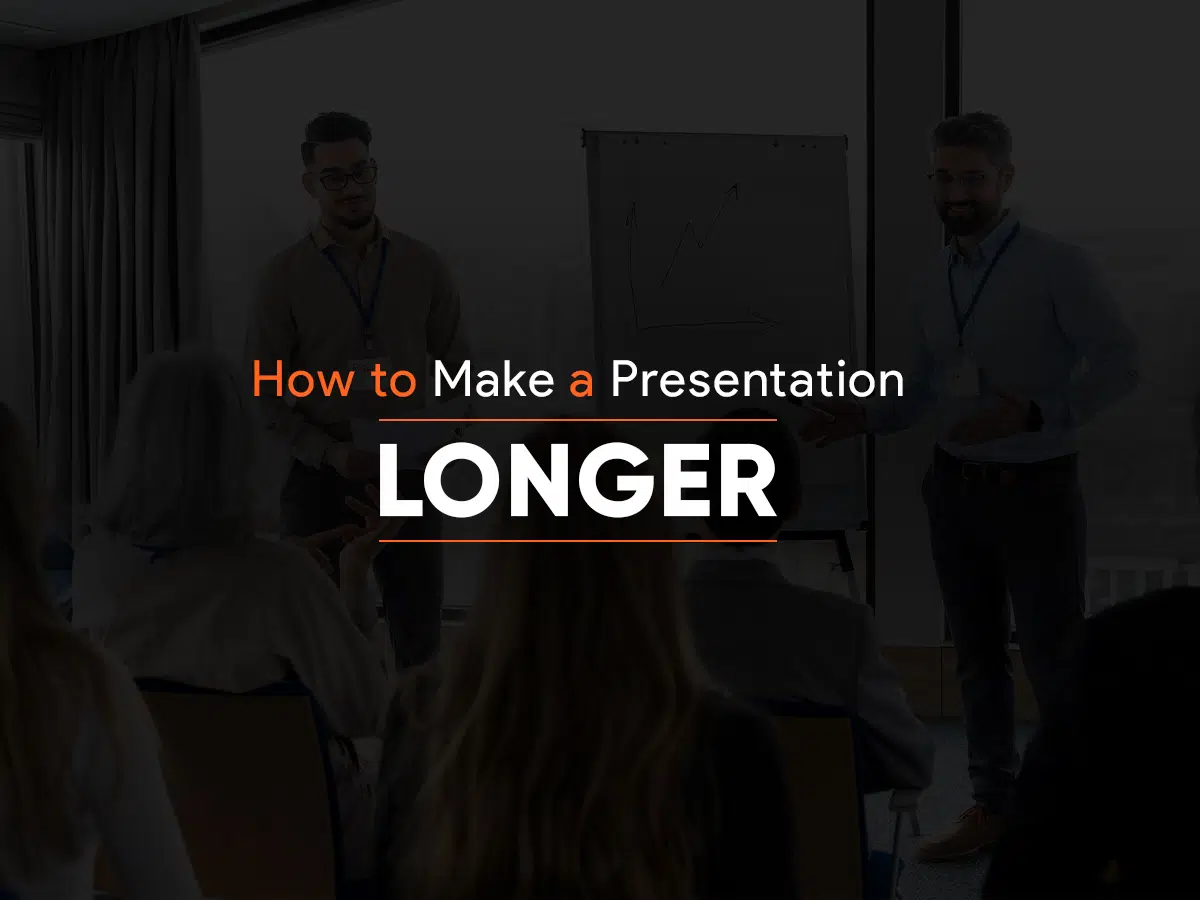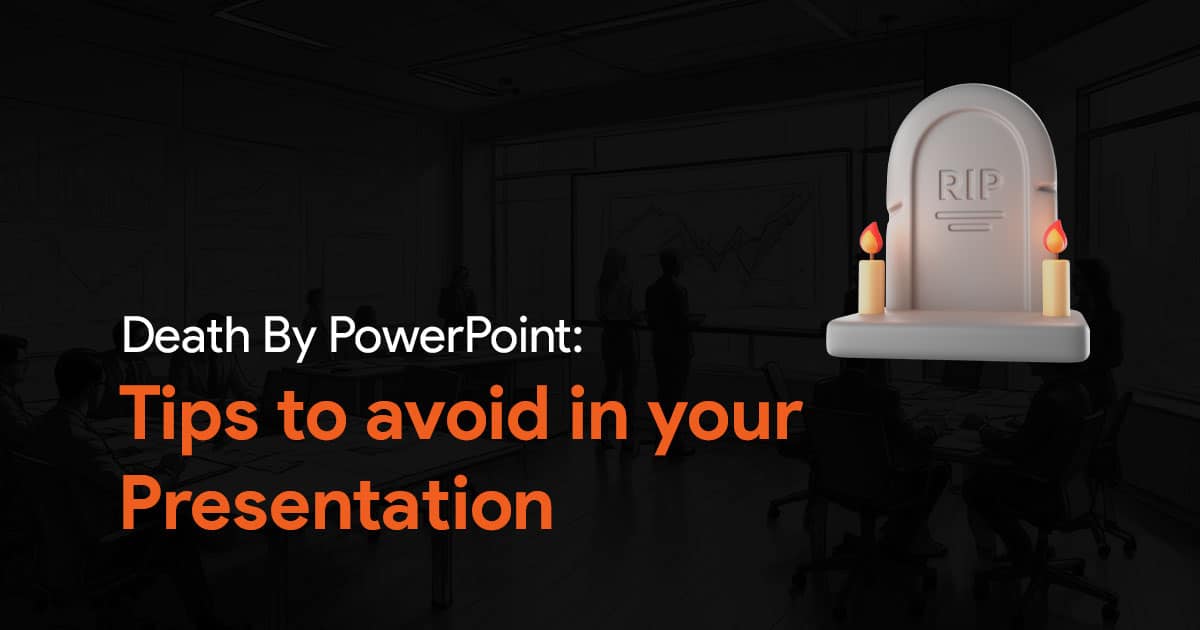- 1 – Start by introducing your topic
- 2 – Prepare beforehand for a longer presentation
- 3 – Expand on your logo and company information
- 4 – Expand on your agenda/timeline
- 5 – Tell a story
- 6 – Use a larger font size for all text, including bullets
- 7 – Use more pictures in your presentation
- 8 – Add music and videos
- 9 – Be the expert!
- 10 – Show several examples of what you are presenting
- 11 – Add transition effects to every slide, no matter how short they may be
- 12 – Try to avoid using text on your slides if you can use a picture or graphic instead
- 13 – Layout a timed schedule for your presentation
- 14 – Present facts and quotes
- 15 – Engage with your audience
- Why would you need a longer presentation?
- Takeaway:
Natural Ways on How to Make a Presentation Longer Without Losing Your Audience

Don’t Just Tell a Story with Your Presentation, Entertain the Audience with It
Are you wondering how to make a PowerPoint presentation longer? Do you ever feel that a PowerPoint presentation is not long enough and wish there was a way to make it longer without having to add more slides or putting more details on each slide? We have good news for you! The trick is not to make it long but keep it interesting and up to the point.
The best speakers don’t talk for 15-20 minutes but can go for an hour or longer without people knowing it. How is that possible? Well, there is a little subtlety involved and it’s called pacing. The average PowerPoint presentation should be about 20 slides long. And for those twenty slides, the content should fit into about five basic categories. If you follow this rule you’ll have a good idea of how to lengthen a PowerPoint presentation and make it seem like time has just flown by.
Everybody likes a good presentation, but sometimes you need to make it longer. If a presentation is too short, people will not get enough information to fully embrace the topic. In this guide, we’ll show you how to lengthen your PowerPoint presentation naturally and easily. Please refer to these 15 tips on how to make a presentation longer naturally.
Table of Contents
- Introduction
– Start by introducing your topic.
– Prepare beforehand for a longer presentation
– Expand on your logo and company information.
– Expand on your agenda/timeline.
– Tell a story.
– Use a larger font size for all text, including bullets.
– Use more pictures in your presentation.
– Add music and videos.
– Be the expert!
– Show several examples of what you are presenting.
– Add transition effects to every slide, no matter how short they may be.
– Try to avoid using text on your slides if you can use a picture or graphic instead.
– Layout a timed schedule for your presentation.
– Present facts and quotes
– Engage with your audience - Why would you need a longer presentation?
- Takeaway
- Conclusion
1 – Start by introducing your topic
First, start by introducing your topic. Begin with a clear statement of what you will be talking about and give a brief overview of the topic. Use an interesting and relevant story that engages the audience, followed by a list of bullet points highlighting key points in the presentation. Finally, end with an attention-grabbing title.
2 – Prepare beforehand for a longer presentation
- Prepare your material beforehand – you should have a good idea of what you want to say before the presentation starts. A good way of doing this is by writing down a list of points and subpoints, which will give you a good outline of your presentation.
- Practice makes perfect – When practicing your presentation, make sure that you practice it multiple times so that there are no mistakes in your delivery of the information. This is quite important if you are going to be presenting on a topic that is new to you. Read through all the slides two days before the actual presentation so that you can know what each slide says and how long each one lasts. Practice until your presentation flows smoothly without any hesitations or awkward pauses between slides. If you practice well enough, you’ll be able to make eye contact with your audience and keep their attention focused on you.
3 – Expand on your logo and company information
You can expand on your logo and company information by:
- Showing the logo at the beginning of the presentation.
- Showing a company’s logo and contact information on a slide before or after each section of your presentation (if applicable).
- Showing a company’s mission statement in one or more slides before or after each section of your presentation (if applicable).
- Sharing some history about how/why your business was started (if applicable).
- Sharing some values that guide decision-making within your organization (if applicable).
4 – Expand on your agenda/timeline
The purpose of your presentation is to inform, persuade or sell. You need to keep this in mind when you’re deciding how much detail to include. If you are presenting a training session, for example, consider including a detailed agenda with the time allotted for each topic outlined on it. For a product demonstration or sales pitch, go through your timeline step-by-step with the audience providing feedback along the way.
If you are presenting a business plan or strategy document, be sure to include details on how things will work from start-up until completion as well as growth projections and profitability expectations over time.
5 – Tell a story
You can use stories to help your audience understand a point and retain it longer. For example, if you’re talking about how to increase productivity and reduce stress, you could tell a story of how you used to work for a company that required long hours every week. You were stressed out all the time because of this and eventually decided that you needed to look for another job where they would let you take breaks when needed. This could help illustrate what happens when people are expected to work long hours without any breaks in between.
Another way that stories can be used is by telling them! It might sound obvious but one of the best ways to keep people engaged during presentations is through storytelling because they are more interesting than facts alone (and let’s face it: who doesn’t love hearing an interesting story?). If there is something interesting or funny about yourself or something relevant that happened with someone else, share it! Your audience will love every second spent listening to your story.
6 – Use a larger font size for all text, including bullets
The font size is another way to make your presentation seem longer. The larger the font, the more slides you can fit on a single screen, and therefore the longer your presentation will seem. But make sure it’s not too large!
Also, be consistent with your fonts throughout—if you’ve used one font for headings and another for text, you’ll get inconsistent results that aren’t as flattering as using just one throughout. And if you’re going big with everything else (bullets and titles), then go small with body copy—it’ll give people something to focus on besides all those slides of text!
7 – Use more pictures in your presentation
A picture is worth a thousand words. This is why you should use more images in your presentation. Images can help break up the text, illustrate your points, explain your points better than words could ever do, make your presentation more visually appealing, and make it easier to remember by forcing people to pay attention longer.
8 – Add music and videos
Adding music or videos to your presentation can help to keep the audience engaged, build up suspense, and even set the mood. It can also convey your message in a more effective way than spoken words alone.
It’s important that you don’t overdo it though! You want to avoid distracting your audience from your content or topic by using music that is too loud or too long, as this will make people lose interest. Likewise, if you add too many videos then it may be difficult for people to follow what’s going on!
9 – Be the expert!
You can also use your own experience and knowledge to make your PowerPoint presentation longer. Be confident in what you have to say. Tell stories that illustrate your points. Don’t be afraid to be enthusiastic about what you are saying, because this will help keep the audience engaged and interested in the topic at hand. You can also add some tips from other experts, if possible; this will help with credibility if it’s done correctly!
10 – Show several examples of what you are presenting
You can also use examples to make your presentation seem longer. Examples are a great way to show what you are talking about; however, if you have too many examples, the audience will lose interest and think that they know everything already.
The best way to use examples is by showing one example at a time and then explaining it thoroughly before moving on to the next one. This way, your presentation seems longer than usual because of all the explanations in between each example.
But wait! There’s more!
The most important thing about using examples is making sure they are relevant both to the audience and yourself as a speaker (or writer). The main goal of an example is not just providing information but helping people understand it better by providing real-life situations where these concepts have been applied successfully or unsuccessfully in the past.
11 – Add transition effects to every slide, no matter how short they may be
- Add transition effects to every slide, no matter how short they may be. The presentation will look more interesting and engaging, and it will help you avoid the problem of having an “all-nighter” with your audience.
- You can also use transitions to show a change in time or location: for example, moving from a house to an office building, from the office building to another building (your home), etc., or from a sunny day to a night time.
12 – Try to avoid using text on your slides if you can use a picture or graphic instead
Use pictures, graphics, charts, graphs, and tables instead of text if you want to make your presentation longer. A picture or graphic will take up less room on the screen than text. This gives you more time to talk about it and gives your audience more time to absorb what they are seeing.
Use a chart instead of text whenever possible! Charts are eye-catching and visually appealing. They also tell a story that can be difficult to convey through words alone.
If you have several points with numbers associated with them (e.g., 10% increase in sales) then try using a graph rather than listing them out one by one as bullet points in bullet slides within the presentation deck itself!
13 – Layout a timed schedule for your presentation
You can practice with a timed schedule to know how long your presentation is, and how much more time you need to add to it to make it longer. When you use a timed schedule to create a PowerPoint presentation, you will be able to focus on your content and not the time. Practicing with a timed schedule helps to develop your sense of pacing so that you can know when to pause for pictures or graphics and how much time to add to the rest of your content in order to make the presentation as long as you want it to be.
14 – Present facts and quotes
Start your presentation with a powerful quote, an interesting fact, or a story that will keep people engaged. This will not only make you seem knowledgeable about the topic that you’re presenting, but it can also catch your audience’s attention and keep them interested.
15 – Engage with your audience
Engage with your audience, ask questions, and get them involved. let them speak out about their opinions and write down short notes where necessary. This will engage your audience with the information that you are presenting, making it easier for them to remember what you said and also lengthen your presentation.
Why would you need a longer presentation?
A longer presentation gives you more time to present the information and discuss your topic with the audience. Longer presentations also help you focus on what is really important about your topic and allows ample room for questions from the audience. If you have lots of figures, charts, graphs, or other types of data that support your presentation, then this is a good time to go with a longer one. Repetition allow you to explain complex information step-by-step, thus allowing the audience to better understand what you are trying to convey.
Takeaway:
Hopefully, you found these tips helpful and are now better prepared to keep your audience engaged with your presentation. The key, of course, is to try and avoid getting too repetitive. Because whether you’re running through a slideshow, or moving your presentation towards a sale; it really doesn’t matter. In the end, you will have made your pitch–and that’s the goal, right?
A good presentation should captivate your audience, inspire them and make them want to listen to you. This is why the length of a presentation should always match its content. The idea of a presentation should be interesting enough for people to pay attention for an hour or two, so you don’t need slides that last longer than that. Some people say that a good way to lengthen your PowerPoint presentation is by including more information in each slide, but this goes against the purpose of using PowerPoint. If you want to get the best out of PowerPoint presentations, make sure you organize your ideas clearly to avoid having too many slides and wasting time on your talk.
In the end, your presentation length should be dictated by your audience and the content you have to share. You can never go wrong with being prepared for both a short and long presentation. In between a good night’s rest and some solid practice time, you can create an excellent presentation that will wow your audience!


